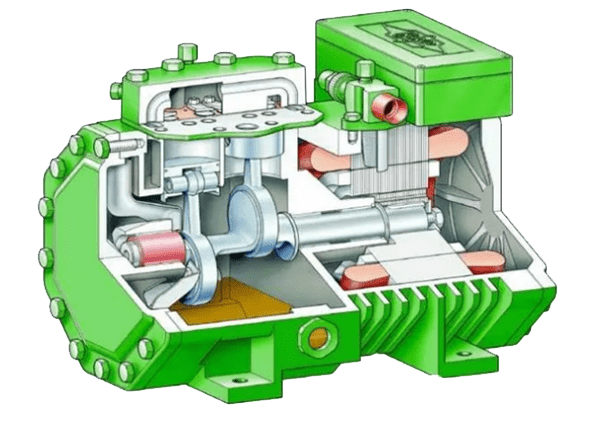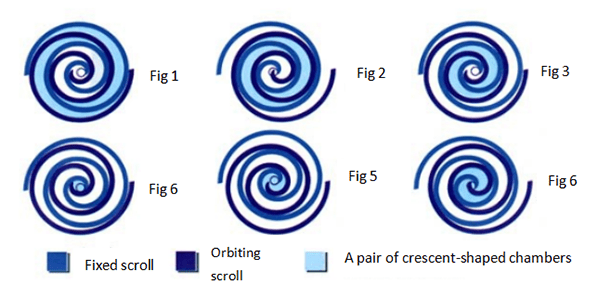
Figure 1: Refrigeration compressors.
The refrigeration compressor is the core energy-consuming component of the refrigeration system, and the capacity and characteristics of the compressor determine the performance of the refrigeration system. The most direct and effective way to improve the efficiency of the refrigeration system is to increase that of the compressor, which will significantly reduce the energy consumption of the system. The following are some commonly used compressors for air conditioning and refrigeration applications, including:
1. Reciprocating compressor
2. Rotary vane compressor
3. Scroll compressor
4. Screw compressor
5. Centrifugal compressor
1. Reciprocating Compressor
When the compressor is working, the electric motor drives the crankshaft of the compressor to rotate, and the piston reciprocates through the transmission of the connecting rod and the crosshead (crank-connecting rod mechanism). The working volume composed of the inner wall of the cylinder, the cylinder head and the top surface of the piston will change periodically.
When the piston starts to move from the cylinder head side, the working volume in the cylinder gradually increases. At this time, the gas goes along the intake pipe, pushes away the suction valve and enters the cylinder until the working volume reaches the maximum, and the suction valve is closed.
When the piston of the reciprocating compressor moves in reverse, the working volume in the cylinder decreases and the gas pressure increases. When the pressure in the cylinder reaches and is slightly higher than the discharge pressure, the exhaust valve opens and the gas is discharged from the cylinder until the piston moves to the limiting position, and the exhaust valve is closed.
The above process repeats when the piston of the reciprocating compressor moves in reverse again. In short, the crankshaft of the reciprocating compressor rotates once and the piston reciprocates once, and the process of intake, compression and discharge is successively realized in the cylinder, that is, a working cycle is completed.

Figure 2: Reciprocating compressor.
2. Rotary Vane Compressor
There are two types of cylinder shapes for rotary vane compressors: round and elliptical. In a round cylinder, there is an eccentric distance between the main shaft of the rotor and the center of the cylinder, so that the rotor is tightly attached between the suction and discharge holes on the inner surface of the cylinder. In an elliptical shape cylinder, the main shaft of the rotor coincides with the center of the ellipse.
The vanes on the rotor divide the cylinder into several spaces. When the main shaft drives the rotor to rotate for one revolution, the volume of these spaces changes continuously, and the volume and temperature of the refrigerant vapor also change in these spaces.
Rotary vane compressors do not have suction valves because the vanes can do the job of sucking in and compressing the refrigerant. If there are 2 vanes, there will be 2 discharge processes for one rotation of the main shaft. The more vanes, the less fluctuations in the gas discharging of the compressor.
Because the volume and weight of the rotary vane compressor can be very small, it is easy to arrange in a narrow engine compartment. Coupled with the advantages of low noise and vibration and high volumetric efficiency, it has also been used in automotive air conditioning systems. However, the rotary vane compressor requires high machining accuracy and high manufacturing cost.

Figure 3: Rotary vane compressor.
3. Scroll Compressor
The scroll compressor is a compressor with a compressible volume composed of a fixed involute scroll and an eccentrically and translationally orbiting involute scroll.
During the working process of suction, compression and discharge, the fixed scroll is fixed on the frame, and the orbiting scroll driven by the eccentric shaft and controlled by the anti-rotation mechanism, rotates in a plane with a small radius around the center of the base circle of the fixed scroll.
The gas is sucked into the periphery of the fixed scroll through the air filter element. With the rotation of the eccentric shaft, the gas is gradually compressed in several crescent-shaped compression chambers formed by the engagement of the fixed and orbiting scrolls and then continuously discharged from the axial hole of the central part of the fixed scroll.

Figure 4: How a scroll compressor compresses refrigerant gas.
4. Screw Compressor
The screw refrigeration compressor is mainly composed of a rotor, a casing (including the cylinder block in the middle and the suction and discharge end seats at both ends), bearings, shaft seals, balance pistons and energy adjustment devices.
The work of the screw compressor relies on the meshing and moving of a male rotor and a female rotor, and is completed by means of the inner wall space of the casing surrounding the pair of rotors.
When the rotor rotates, the "V"-shaped inter-tooth volume formed by the rotor's teeth, tooth grooves and the inner wall of the casing, is called the working volume, and its volume will change periodically. At the same time, the working volume will also move along the axial direction of the rotor from the side of the suction port to the side of the discharge port, sucks in and compresses the refrigerant gas to a certain pressure and then discharges it.

Figure 5: Screw compressor.
5. Centrifugal Compressor
The rotor of the centrifugal compressor is generally driven by an electric motor through a gear increaser. When the impeller of the compressor rotates, the refrigerant gas enters the flow passage of the impeller from the suction chamber, and the gas rotates with the impeller under the push of the impeller blades. Due to the action of centrifugal force, the gas flows radially along the flow passage of the impeller and leaves the impeller, and at the same time a low pressure forms at the inlet of the impeller, and the gas is continuously sucked in through the suction pipe.
During this process, the impeller does work on the gas to increase its kinetic energy and pressure energy, so the pressure and flow velocity of the gas are increased. Then the gas at high speed enters the diffuser and volute whose cross-section gradually expands, the flow velocity gradually decreases, most of the kinetic energy of the gas is converted into pressure energy, the pressure is further increased, and then the gas is discharged from the compressor.

Figure 6: Centrifugal refrigeration compressor.
Centrifugal refrigeration compressors have various structural forms such as single-stage, double-stage and multi-stage. The single-stage compressor is mainly composed of a suction chamber, an impeller, a diffuser, and a volute. For multi-stage compressors, there are also components such as bends and backflow preventers. Multi-stage centrifugal refrigeration compressors have several impellers working in series on the main shaft to achieve a high pressure ratio.
Related Info
5 Types of Compressors for Central AC (Working Principles, Pros and Cons)Mitsubishi vs. Daikin vs. Hitachi vs. Toshiba: Which is the Best Central Air Conditioner Brand?
What is a VRV Air Conditioning System
What Does the Compressor Do in the Refrigeration System
What are Refrigeration and Air-Conditioning Compressor Heaters Used For


